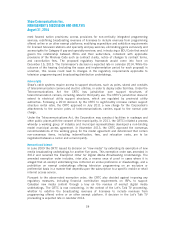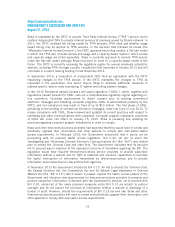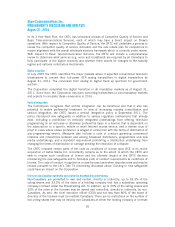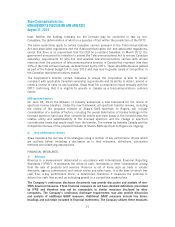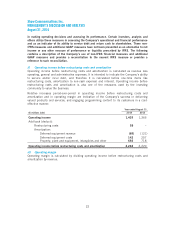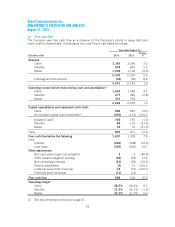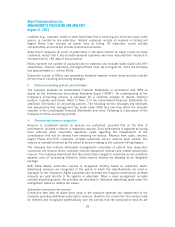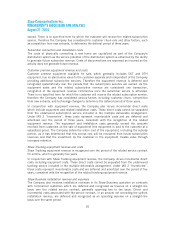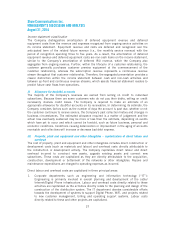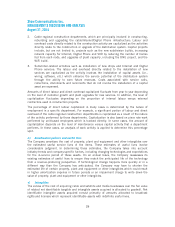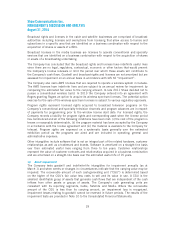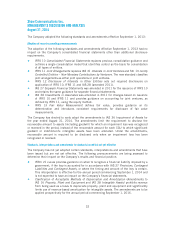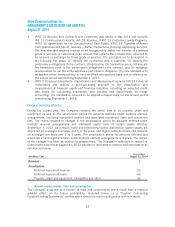Shaw 2014 Annual Report Download - page 31
Download and view the complete annual report
Please find page 31 of the 2014 Shaw annual report below. You can navigate through the pages in the report by either clicking on the pages listed below, or by using the keyword search tool below to find specific information within the annual report.Shaw Communications Inc.
MANAGEMENT’S DISCUSSION AND ANALYSIS
August 31, 2014
Income statement classification
The Company distinguishes amortization of deferred equipment revenue and deferred
equipment costs from the revenue and expenses recognized from ongoing service activities on
its income statement. Equipment revenue and costs are deferred and recognized over the
anticipated term of the related future revenue (i.e., the monthly service revenue) with the
period of recognition spanning three to five years. As a result, the amortization of deferred
equipment revenue and deferred equipment costs are non-cash items on the income statement,
similar to the Company’s amortization of deferred IRU revenue, which the Company also
segregates from ongoing revenue. Further, within the lifecycle of a customer relationship, the
customer generally purchases customer premise equipment at the commencement of the
customer relationship, whereas the subscription revenue represents a continuous revenue
stream throughout that customer relationship. Therefore, the segregated presentation provides a
clearer distinction within the income statement between cash and non-cash activities and
between up-front and continuous revenue streams, which assists financial statement readers to
predict future cash flows from operations.
ii) Allowance for doubtful accounts
The majority of the Company’s revenues are earned from selling on credit to individual
subscribers. Because there are some customers who do not pay their debts, selling on credit
necessarily involves credit losses. The Company is required to make an estimate of an
appropriate allowance for doubtful accounts on its receivables. In determining its estimate, the
Company considers factors such as the number of days the account is past due, whether or not
the customer continues to receive service, the Company’s past collection history and changes in
business circumstances. The estimated allowance required is a matter of judgement and the
actual loss eventually sustained may be more or less than the estimate, depending on events
which have yet to occur and which cannot be foretold, such as future business, personal and
economic conditions. Conditions causing deterioration or improvement in the aging of accounts
receivable and collections will increase or decrease bad debt expense.
iii) Property, plant and equipment and other intangibles – capitalization of direct labour and
overhead
The cost of property, plant and equipment and other intangibles includes direct construction or
development costs (such as materials and labour) and overhead costs directly attributable to
the construction or development activity. The Company capitalizes direct labour and direct
overhead incurred to construct new assets, upgrade existing assets and connect new
subscribers. These costs are capitalized as they are directly attributable to the acquisition,
construction, development or betterment of the networks or other intangibles. Repairs and
maintenance expenditures are charged to operating expenses as incurred.
Direct labour and overhead costs are capitalized in three principal areas:
1. Corporate departments such as engineering and information technology (“IT”):
Engineering is primarily involved in overall planning and development of the cable/
Internet/Digital Phone infrastructure. Labour and overhead costs directly related to these
activities are capitalized as the activities directly relate to the planning and design of the
construction of the distribution system. The IT department devotes considerable efforts
towards the development of systems to support Digital Phone, WiFi, and projects related
to new customer management, billing and operating support systems. Labour costs
directly related to these and other projects are capitalized.
27



